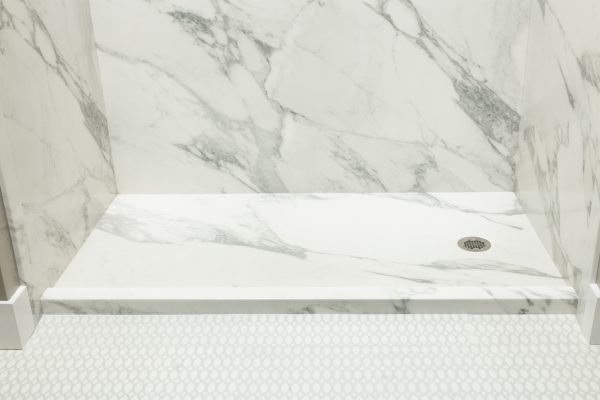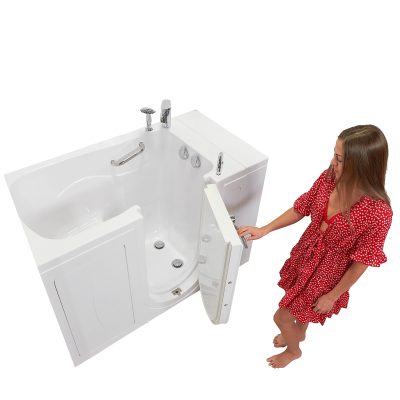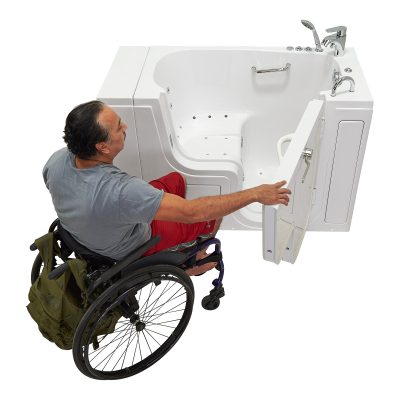What is the cost of a walk-in bathtub or shower suitable for safety reasons?
Curbless showers — also called low-threshold showers — help eliminate tripping hazards are they don’t have any threshold or lip to step over.
TubToday, Shower seats or benches allow older adults to sit down if necessary.
Everyone enjoys a relaxing bath or an invigorating shower. But for the elderly or disabled, traditional bathtubs and showers can present a safety challenge.
Taking that first step into a bathtub or shower, especially without assistance, can lead to slips, falls, and fractures — the most common types of injuries among the elderly. However, a walk-in bathtub or shower can address this safety concern with its low-barrier threshold and compliant seating.
A traditional bathtub stands 14 to 22 inches from the ground. The tub bather must be able to lift one leg over the edge while balancing on the other leg for support, then be able to lower their body into the tub at the start of the bath and pull out when finished.
Welcome to a walk-in tub: a vertical version of a traditional bathtub. Walk-in tubs provide more stability during bathing than conventional bathtubs.
to a walk-in tub: a vertical version of a traditional bathtub. Walk-in tubs provide more stability during bathing than conventional bathtubs.
A door on the front allows the bather to step over a minimal threshold, often just a few inches in height. Once inside, the bather can sit down in a preformed chair part of the tub.
The bather shuts the door and activates the water faucets to fill the tub. Those who cannot pull themselves out of a traditional tub can quickly exit a walk-in tub, and people who cannot shower because of stability issues enjoy an easy-access bath.
Nic Boutner, the owner of TubToday, has been busy remodeling bathrooms to simplify the bathing experience. Most of that remodeling takes out the tub and replaces it with a walk-in shower.
“The term for the elderly within the industry is ‘live in place’ or ‘age in place,'” he said. “This allows a person to stay in the home for as long as possible.
“Another term is ‘multigenerational home’ where a parent or loved one is living with a family relative. Most of the replacements in the family home are done in the master bath, and if the person in need lives with a relative, then the remodel is usually in the guest or hall bathroom.”
The bath remodel can include features such as choice of color, lights, jet faucets, and sound system. Primack makes sure the doorway is wide enough for access if the person is using a wheelchair or walker, and he can add grab or safety bars to ensure a safe experience. Patients who use wheelchairs can make an easier transition from chair to the tub, while caretakers have an easier time helping patients in and out of the tub.
“Our job is to make a client’s life better,” Nic said. “I receive literature that keeps me updated on innovative ways to make a bath safer. Our client base ranges from 45 to 75 years old and has questions about making their bathroom safer. We strive to keep our clients out of rehab, especially a nursing home, by avoiding preventable injuries.
“Once our job is complete, some customers have returned to give my staff or me a hug because we have made their lives better. I’m often asked about other bathroom safety features, and the most requested include toilets that sit taller off the ground, nonslip floors, and adding safety bars.”
Barrier-free shower stalls are a good idea for anyone aging in place.
Most showers have a 2-or 3-inch threshold. Usually, this works well, but if someone uses a walker, a wheelchair, or has trouble lifting his legs, getting over that seemingly small hump can be daunting.
Customers can add Seats or benches, and, of course, grab bars are also essential and should be sturdy enough to support as much as 300 pounds.
Nic and his team can visit your home, show various conversions, and compare a walk-in tub to a walk-in shower. He has taken small showers and expanded them up to 12 feet long. The transformation of either can take three days up to four weeks depending on the specific needs and goals of the client and changes in plumbing and electrical upgrades.
Nic points out that there are issues to consider before installing a walk-in bathtub.
“Walk-in tubs take five to seven minutes to fill, and the process cannot begin until the user steps in,” he said. “It takes two to four minutes to drain. Because the water is holding the door shut, the bather must wait for the water to drain completely before stepping out. Walk-in tubs often aren’t as spacious as traditional tubs, and once installed, it becomes a permanent household fixture.”
Installing a walk-in bathtub requires time, planning, and financial investment. And that Medicare may not cover financial investment as it does not currently consider walk-in tubs to be “durable medical equipment” and will not reimburse the cost of purchase or installation.
Some Medicaid plans will consider a partial compensation for walk-in tubs, but, in general, the user would have to demonstrate a bona fide medical need. However, qualified walk-in tub owners can deduct certain expenses (including a therapeutic walk-in tub) if dependents live in the home.


VERDI – TubToday Exclusive
Inward Swing, Walk-in Tubs by TubToday
TUBTODAY Exclusive
Inward Swing, Walk-in Tubs by TubToday
Ultimate
Inward Swing, Walk-in Tubs by TubToday
Tub4Two
Outward Swing, Two Seat, Walk-in Tubs by TubToday
Bathroom Accessories
48 Products
Bathroom Storage
10 Products
Bathtubs
48 Products
Custom Vanity Tops
14 Products
Flooring
84 Products